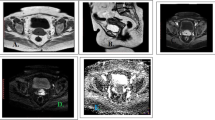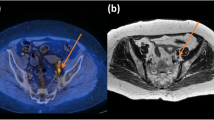Abstract
Purpose
To evaluate the clinical value of magnetic resonance whole-body diffusion-weighted imaging (WB-DWI) in the staging of uterine cervical carcinoma.
Materials and methods
Twenty-six patients with untreated uterine cervical carcinoma received preoperative conventional MR and WB-DWI scans. WB-DWI scans were also obtained in 30 healthy volunteers. Measurements of apparent diffusion coefficient (ADC) were made on scans of normal uterine cervix and uterine cervical carcinoma, and benign and metastatic lymph nodes. Statistical analysis was applied to the obtained data.
Results
Mean ADC value of uterine cervical carcinoma was significantly lower than the 3 layers of normal uterine cervix (P = 0.00). When an ADC value of 1.28 × 10−3 mm2/s is used as the threshold, its sensitivity is 96%, specificity is 100%, and accuracy is 98%. Mean ADC value of metastatic nodes [(0.96 ± 0.14) × 10−3 mm2/s] was significantly lower than that of benign nodes [(1.39 ± 0.19) × 10−3 mm2/s] (t = 9.93, P = 0.00). When an ADC value of 1.14 × 10−3 mm2/s is used as the threshold, its sensitivity is 83%, specificity is 98%, and accuracy is 94%.
Conclusion
WB-DWI scan is capable of distinguishing uterine cervical carcinoma from normal uterine cervix, and is capable of separating metastatic nodes from benign nodes.






Similar content being viewed by others
References
Charles-Edwards EM, Messiou C, Morgan VA, et al. (2009) Diffusion-weighted imaging in cervical cancer with an endovaginal technique: potential value for improving tumor detection in stage Ia and Ib1 disease. Radiology 249:541–550
Chen YB, Liao J, Xie R, et al. (2009) Discrimination of metastatic from hyperplastic pelvic lymph nodes in patients with cervical cancer by diffusion-weighted magnetic resonance imaging. Abdom Imaging. doi:10.1007/s00261-009-9590-z
Yen TC, Ng KK, Ma SY, et al. (2003) Value of dual-phase 2-fluoro-2-deoxy-d-glucose positron emission tomography in cervical cancer. J Clin Oncol 21:3651–3658
Lai CH, Huang KG, See LC, et al. (2004) Restaging of recurrent cervical carcinoma with dual-phase [18F]fluoro-2-deoxy-D-glucose positron emission tomography. Cancer 100:544–552
Chang TC, Law KS, Hong JH, et al. (2004) Positron emission tomography for unexplained elevation of serum squamous cell carcinoma antigen levels during follow-up for patients with cervical malignancies: a phase II study. Cancer 101:164–171
Yen TC, See LC, Lai CH, et al. (2008) Standardized uptake value in para-aortic lymph nodes is a significant prognostic factor in patients with primary advanced squamous cervical cancer. Eur J Nucl Med Mol Imaging 35:493–501
Komori T, Narabayashi I, Matsumura K, et al. (2007) 2-[Fluorine-18]-fluoro-2-deoxy-D-glucose positron emission tomography/computed tomography versus whole-body diffusion-weighted MRI for detection of malignant lesions: initial experience. Ann Nucl Med 21:209–215
Yen TC, Chang JT, Ng SH, et al. (2005) The value of 18F-FDG PET in the detection of stage M0 carcinoma of the nasopharynx. J Nucl Med 46:405–410
Takahara T, Imai Y, Yamashita T, et al. (2004) Diffusion weighted whole body imaging with background body signal suppression (DWIBS): technical improvement using free breathing, STIR and high resolution 3D display. Radiat Med 22:275–282
Ohno Y, Koyama H, Onishi Y, et al. (2008) Non-small cell lung cancer: whole-body MR examination for M-stage assessment—utility for whole-body diffusion-weighted imaging compared with integrated FDG PET/CT. Radiology 248:643–654
Nakanishi K, Kobayashi M, Nakaguchi K, et al. (2007) Whole-body MRI for detecting metastatic bone tumor: diagnostic value of diffusion-weighted images. Magn Reson Med Sci 6:147–155
Vilanova JC, Barceló J, et al. (2008) Diffusion-weighted whole-body MR screening. Eur J Radiol 67:440–447
Xue HD, Li S, Sun F, et al. (2008) Clinical application of body diffusion weighted MR imaging in the diagnosis and preoperative N staging of cervical cancer. Chin Med Sci J 23:133–137
Wang J, Takashima S, Takayama F, et al. (2001) Head and neck lesions: characterization with diffusion-weighted echo-planar MR imaging. Radiology 220:621–630
Sumi M, Sakihama N, Morikawa M, et al. (2003) Discrimination of metastatic cervical lymph nodes with diffusion-weighted MR imaging in patients with head and neck cancer. AJNR 24:1627–1634
Naganawa S, Sato C, Kumada H, et al. (2005) Apparent diffusion coefficient in cervical cancer of the uterus: comparison with the normal uterine cervix. Eur Radiol 15:71–78
Abdel Razek AA, Soliman NY, Elkhamary S, et al. (2006) Role of diffusion-weighted MR imaging in cervical lymphadenopathy. Eur Radiol 16:1468–1477
Williams AD, Cousins C, Soutter WP, et al. (2001) Detection of pelvic lymph node metastases in gynecologic malignancy: a comparison of CT, MR imaging, and positron emission tomography. AJR Am J Roentgenol 177:343–348
Nakai G, Matsuki M, Inada Y, et al. (2008) Detection and evaluation of pelvic lymph nodes in patients with gynecologic malignancies using body diffusion-weighted magnetic resonance imaging. J Comput Assist Tomogr 32:764–768
Author information
Authors and Affiliations
Corresponding author
Rights and permissions
About this article
Cite this article
Chen, Y.B., Hu, C.M., Chen, G.L. et al. Staging of uterine cervical carcinoma: whole-body diffusion-weighted magnetic resonance imaging. Abdom Imaging 36, 619–626 (2011). https://doi.org/10.1007/s00261-010-9642-4
Published:
Issue Date:
DOI: https://doi.org/10.1007/s00261-010-9642-4




